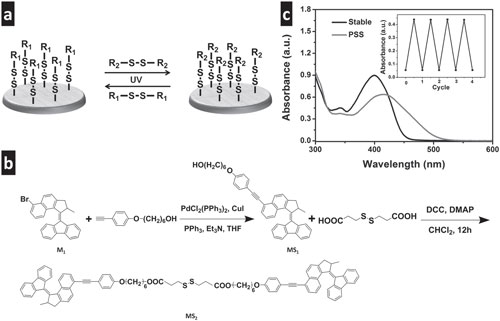| Posted: Jun 09, 2017 | |
A general strategy for reprogrammable assembly molecular motors on solid surfaces(Nanowerk News) The design of synthetic molecular motors that can perform useful work has been a challenging long-term goal of nanotechnology. |
|
| Molecular motors based on overcrowded alkenes are promising systems because they can present repetitive and monodirectional rotation triggered by external stimuli | |
| Although molecular motors have been reported to operate various tasks in liquid systems, such as controlling the chiral space in a catalytic reaction, inducing reflective color in cholesteric liquid crystals, and rotating micro-objects, Brownian motion provides a considerable hurdle to overcome in exploring applications exploiting the rotary cycle to power molecular machines and devices. | |
| To this end, covalent and noncovalent approaches toward the immobilization of molecular motors on solid surfaces have been explored. The recent development of dynamic bonds in building smart surfaces has resulted in capabilities to operate 'write and erase' procedures, form complex, multicomponent, and gradient patterns, and in situ manipulate local environments. | |
| A research group in China has demonstrated a general strategy for reprogrammable assembly molecular motors on solid surfaces based on dynamic bonds. | |
 |
|
| a) Schematic illustration of reversible surface modification based on a photodynamic disulfide exchange reaction. b) Synthesis procedure of a molecular motor with a disulfide bond from a parent molecular motor containing a bromo substituent. c) UV–vis spectra of a molecular motor with disulfide bonds before (black solid line) and after (gray solid line) irradiation of UV at room temperature in CH2Cl2. The inset shows a change of absorption at 450 nm for a molecular motor with disulfide bonds after several irradiation/relaxation cycles. (© Wiley-VCH Verlag) (click on image to enlarge) | |
| Reporting their findings in Small ("Reprogrammable Assembly of Molecular Motor on Solid Surfaces via Dynamic Bonds"), they showed that molecular motors with disulfide bonds can be assembled on solid surfaces modified by disulfide bonds, regardless of their chemical composition and microstructure. | |
| Moreover, both positional and orientational orders of molecular motors on solid surfaces promising their collective motion have been achieved. | |
| Due to reversible assembly and release behaviors of molecular motors on solid surfaces by the photocleavage and recombination of disulfide bonds, solid surfaces can act as 'computer hardware', while molecular motor geometric information can be reformatted and reprogramed repeatedly. | |
| The team concludes that this strategy is potentially applied in other molecular switches for developing functional devices. |
 By
Michael
Berger
– Michael is author of three books by the Royal Society of Chemistry:
Nano-Society: Pushing the Boundaries of Technology,
Nanotechnology: The Future is Tiny, and
Nanoengineering: The Skills and Tools Making Technology Invisible
Copyright ©
Nanowerk LLC
By
Michael
Berger
– Michael is author of three books by the Royal Society of Chemistry:
Nano-Society: Pushing the Boundaries of Technology,
Nanotechnology: The Future is Tiny, and
Nanoengineering: The Skills and Tools Making Technology Invisible
Copyright ©
Nanowerk LLC
|
|
|
Subscribe to a free copy of one of our daily Nanowerk Newsletter Email Digests with a compilation of all of the day's news. |
